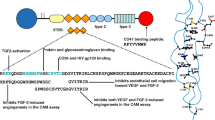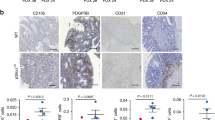Abstract
Neoangiogenesis is essential for tumor and metastasis growth, but this complex process does not follow the same activation pathway, at least in tumor cell lines originated from different murine mammary adenocarcinomas. LMM3 cells were the most potent to stimulate new blood vessel formation. This response was significantly reduced by preincubating cells with indomethacin and NS-398, non-selective cyclooxygenase (COX) and COX-2 selective inhibitors, respectively. COX-1 and COX-2 isoenzymes were both highly expressed in LMM3 cells, and we observed that indomethacin was more effective than NS-398 to inhibit prostaglandin E2(PGE2) synthesis. In addition, nitric oxide synthase (NOS) inhibitors, N ωmonomethyl l-arginine and aminoguanidine, also reduced LMM3-induced angiogenesis and nitric oxide (NO) synthesis as well. NOS2 > NOS3 proteins and arginase II isoform were detected in LMM3 cells by Western blot. The latter enzyme was also involved in the LMM3 neovascular response, since the arginase inhibitor, N ω hydroxy l-arginine reduced the angiogenic cascade. On the other hand, parental LM3 cells were able to stimulate neovascularization via COX-1 and arginase products since only indomethacin and N ω hydroxy l-arginine, which diminished PGE2 and urea synthesis, respectively, also reduced angiogenesis. In turn, LM2 cells angiogenic response could be due in fact to PGE2-induced VEGF liberation that stimulated neoangiogenesis at very low levels of NO.
Similar content being viewed by others
References
Folkman J. Tumor angiogenesis. Adv Cancer Res 1985; 43: 175–203.
Moncada S, Higgs A, Furchgott R. XIV International Union of Pharmacology Nomenclature in Nitric Oxide Research. Pharmacol Rev 1997; 40: 137–42.
Colasanti M, Suzuki H. The dual personality of NO. Trends Pharmacol Sci 2000; 21: 249–52.
Wu G, Morris SM. Arginine metabolism: Nitric oxide and beyond.Biochem J 1998; 337: 1–17.
Prescott SM, Fitzpatrick FA. COX-2 and carcinogenesis. Biochem Biophys Acta 2000; 1470: M69–M78.
Salvemini D. Cyclooxygenase: An important transduction system for the multifaceted roles of nitric oxide. In Rubanyi GM (ed): Pathophysiology and Clinical Application of Nitric Oxide.Richmond, California: Harwood Academic Publishers 1999; Vol. 5, 155–70.
Tsuji M, Kawano S, Tsuji S et al. Cyclooxygenase regulates angiogenesis induced by colon cancer cells. Cell 1998; 93: 705–16.
Galli S, Colombo L, Vanzuli S et al. Characterization of a fibroblastoid mammary carcinoma cell line (LM2) originated from a mouse adenocarcinoma. Int J Oncol 2000; 17: 1259–65.
Urtreger A, Laeda VE, Puricelli L et al. Modulation of fibronectin expression and proteolytic activity associated with the invasive and metastatic phenotype in two murine mammary tumor cell lines. Int J Oncol 1997; 11: 489–96.
Monte M, Davel L, Sacerdote de Lustig E. Hydrogen peroxide is involved in lymphocyte activation mechanisms to induce angiogenesis.Eur J Cancer 1997; 33: 676–82.
Granstrom E, Kindhal H. Radioimmunoassay of prostaglandins and thomboxanes research. In Frolich JC (ed): Advances in Prostaglandin and Thromboxanes Research. New York: Raven Press 1978; 119–210.
Lowry O, Rosebrough N, Randall R et al. Protein measurement with Folin phenol reagents. J Biol Chem 1971; 193: 265–8.
Green LC, Wagner DA, Glogowski J et al. Analysis of nitrate nitrite and (15N) in biological fluids. Anal Biochem 1982; 126: 131–8.
Modolell M, Corraliza IM, Link F et al. Reciprocal regulation of the nitric oxide synthase/arginase balance in mouse bone marrowderived macrophage by TH1 and TH2 cytokines. Eur J Immunol 1995; 25: 1101–4.
Gotoh T, Sonoki A, Nagasaki K et al. Molecular cloning of cDNA for nonhepatic mitochondrial arginase (arginase II) and comparison of its induction with nitric oxide synthase in a murine macrophage-like cell line. FEBS Lett 1996; 395: 119–22.
Gotoh T, Mori M. Arginase II downregulates nitric oxide (NO) production prevents NO-mediated apoptosis of murine macrophage-derived RAW 264.7 cells. J Cell Biol 1999; 144: 427–34.
Bergers G, Benjamin LE. Tumorigenesis and the angiogenic switch. Nature Cancer Rev 2003; 3: 401–10.
Uefuji K, Ichikura T, Mochizuki H. Cyclooxygenase-2 expression is related to prostaglandin biosynthesis and angiogenesis in human gastric cancer. Clin Cancer Res 2000; 6: 135–8.
Higashi Y, Kanekura T, Kanzaki T. Enhanced expression of cyclooxygenase (COX)-2 in human skin epidermal cancer cell: Evidence for growth suppression by inhibiting COX-2 expression.Int J Cancer 2000; 86: 667–71.
Subbaramaiah K, Telang N, Ramonetti J et al. Transcription of cyclooxygenase-2 is enhanced in transformed mammary epithelial cells. Cancer Res 1996; 56: 4424–9.
Sales KJ, Katz AA, Howard B et al. Cyclooxygenase-1 is upregulated in cervical carcinomas: Autocrine/paracrine regulation of cyclooxygenase-2, prostaglandin E receptors and angiogenic factors by cyclooxygenase-1. Cancer Res 2002; 62: 424–32.
Lala PK, Orucevic A. Role of nitric oxide in tumor progression: Lessons from experimental tumor progression. Cancer Met Rev 1998; 17: 91–106.
Davel L, Eijan AM, Sales ME et al. Reactivity of tumor lymph nodes and the nitric oxide pathway. Int J Oncol 2002; 20: 59–67.
Bruch-Gerharz D, Schnorr O, Suschek C et al. Arginase 1 overexpression in psoriasis: Limitation of inducible nitric oxide synthase activity as a molecular mechanism for keratinocyte hyperproliferation. Am J Pathol 2003; 162: 203–21.
Li H, Meininger CJ, Kelly KA et al. Activities of arginase I and II are limiting for endothelial cell proliferation. Am J Physiol Reg Integr Comp Physiol 2002; 282: R64–R9.
Davel LE, Jasnis MA, de la Torre E et al. Arginine metabolic pathways involved in the modulation of tumor induced angiogenesis by macrophages. FEBS Lett 2002; 532: 216–20.
Singh R, Pervin S, Karimi A et al. Arginase activity in human breast cancer cell lines: N(omega)-hydroxy-L-arginine selectively inhibits cell proliferation and induces apoptosis in MDA-MB-468 cells. Cancer Res 2000; 60: 3305–12.
Ferrara N. VEGF and the quest for tumor angiogenesis factor.Nature Cancer Rev 2002; 2: 795–803.
Joo YE, Rew JS, Seo YH et al. Cyclooxygenase-2 overexpression correlates with vascular endothelial growth factor expression and tumor angiogenesis in gastric cancer. J Clin Gastroenterol 2003; 37: 28–33.
Kisley L R, Barrett BS, Bauer AK et al. Genetic ablation of inducible nitric oxide synthase decreases mouse lung tumorigenesis.Cancer Res 2002; 62: 6850–6.
Davel L, D'Agostino A, Español A et al. Nitric oxide synthasecyclooxygenase interactions are involved in tumor cell angiogenesis and migration. J Biol Reg Homeost Agents 2002; 16: 181–9.
Kroll J, Waltenberger J. VEGF-A induces expression of eNOS and iNOS in endothelial cells via VEGF receptor 2 (KDR). Biochem Biophys Res Commun 1998; 252: 743–6.
Author information
Authors and Affiliations
Corresponding author
Rights and permissions
About this article
Cite this article
Davel, L.E., Rimmaudo, L., Español, A. et al. Different Mechanisms Lead to the Angiogenic Process Induced by Three Adenocarcinoma Cell Lines. Angiogenesis 7, 45–51 (2004). https://doi.org/10.1023/B:AGEN.0000037329.45326.a8
Issue Date:
DOI: https://doi.org/10.1023/B:AGEN.0000037329.45326.a8




